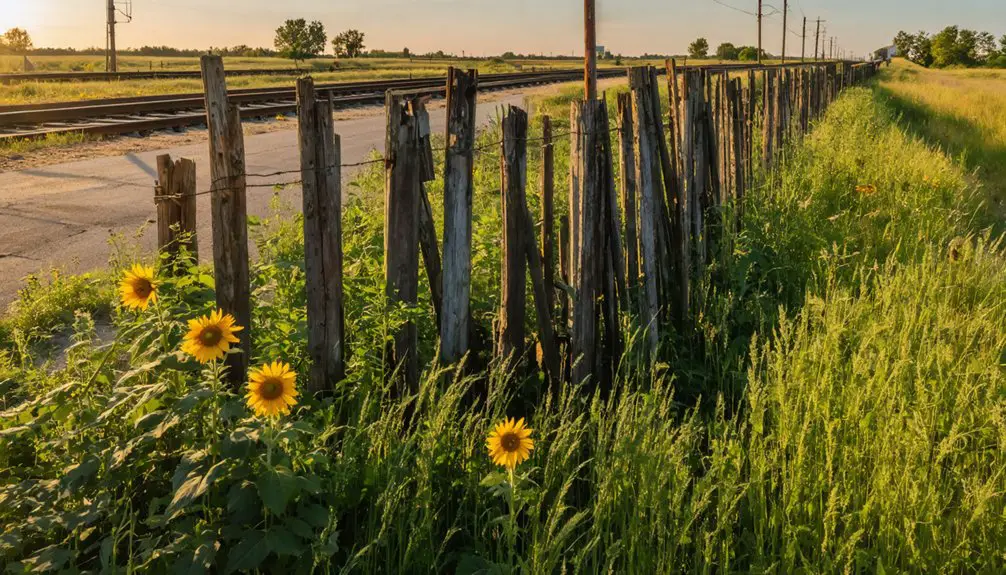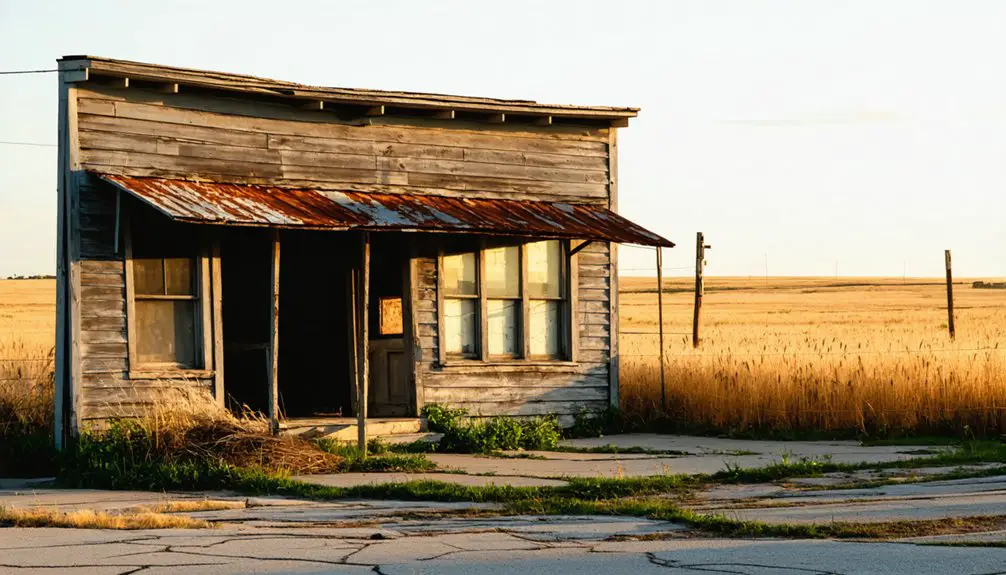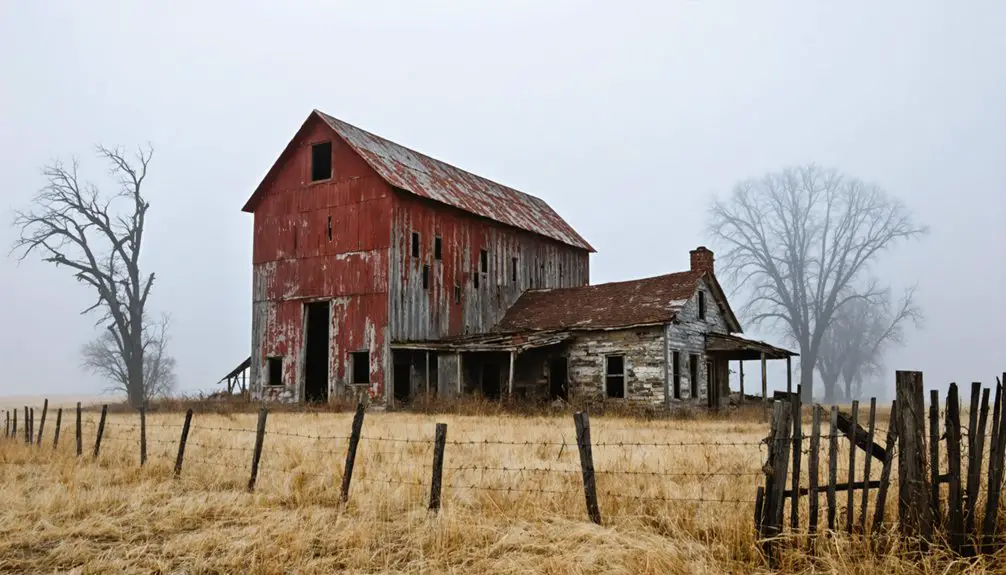You’ll find Hartland’s scattered ruins amid Kansas farmland, where this ambitious town once rivaled Lakin for the Kearny County seat in 1889. At its peak, 500 residents called Hartland home, with Paul Tromp’s general store serving as the community hub along the Santa Fe Trail. After a courthouse fire in 1894, Hartland lost its county seat status to Lakin and gradually faded away. Today, stone foundations, bridge supports, and a remote cemetery tell a deeper story of prairie ambition and loss.
Key Takeaways
- Hartland was a Kansas railroad town that peaked at 500 residents before losing its county seat status to Lakin in 1894.
- The town’s decline began after a courthouse fire in 1894, transforming from a bustling community into abandoned farmland.
- Physical remnants include stone foundations, bridge supports, Main Street ruts, and a cemetery northeast of the former town.
- Paul Tromp’s general store was the community hub until its closure following a gasoline explosion incident.
- The Santa Fe Trail marker and deteriorating cemetery are the main preserved historical elements of this Kansas ghost town.
The Rise and Fall of a County Seat
When Kearny County organized in 1888, the race for county seat sparked an intense rivalry between the railroad town of Lakin and the newly established Hartland. The railroad’s significance shaped both towns’ ambitions, with Lakin holding temporary county seat status due to its established rail facilities.
You’ll find Hartland strategically positioned at Bear Creek’s mouth, where it leveraged its natural pass through the sand hills to vie for prominence. The town quickly grew to five hundred residents during its peak years. By May 1886, the town’s rapid development included over 125 buildings housing both residences and businesses.
In February 1889, Hartland won the county seat election, but Lakin’s officials wouldn’t surrender without a fight. They hired guards, hid records, and battled through courts until January 1890, when the Kansas Supreme Court ruled in Hartland’s favor.
Yet Hartland’s victory proved short-lived – a suspicious courthouse fire in 1894 led to a special election returning the county seat to Lakin, spelling Hartland’s eventual doom.
Life Along the Santa Fe Trail
Before Hartland’s brief reign as county seat, the Santa Fe Trail played an essential role in shaping the region’s development.
As you’d travel these historic trade routes, you’d encounter a vibrant mix of commercial traders, military convoys, and pioneer journeys that took roughly eight weeks to complete. The trail stretched 900 miles long from Franklin, Missouri to Santa Fe, New Mexico. Travelers faced dangerous encounters with hostile Native tribes, except for the friendly Pueblo Indians.
Life along the trail wasn’t easy, but established rest stops made the journey manageable:
- Oxen pulled heavy wagons, chosen for their endurance and practicality as emergency food
- Military escorts protected travelers from raids, especially after 1829
- Trading posts and camping stations like Diamond Spring offered vital resupply points
The trail’s importance grew considerably after 1848, as traders hauled manufactured goods westward and returned with silver, furs, and mules until the railroad’s arrival in 1880 changed everything.
Architectural Legacy in Stone and Soil
Today’s remaining traces of Hartland tell a bittersweet story in stone and soil, as foundations peek through prairie grass where a bustling frontier town once stood.
Sara Madison and her family initially lived in a canvas tent while constructing what would become the town’s premier hotel.
You’ll find stone steps that once led to the general store, bridge supports along the river, and the old school’s foundation – silent witnesses to Hartland’s architectural significance.
The Madison House Hotel symbolized the town’s prosperity in the 1880s, requiring an oversized lot to accommodate travelers arriving by train and stagecoach.
While historical preservation wasn’t a priority after the county seat moved to Lakin in 1894, stone foundations outlasted wooden structures, marking where courthouses and commercial buildings once thrived.
Stone foundations stubbornly persist in the prairie grass, outlasting the wooden buildings that once made Hartland a thriving frontier town.
Like many Kansas towns affected by bad weather and mining decline, Hartland’s fate mirrored other ghost towns that succumbed to harsh environmental and economic conditions.
The last house fell just five years ago, as ranchers repurposed materials for cattle operations, leaving only the cemetery northeast of town to chronicle Hartland’s final chapter.
Tales From the General Store
Among the stone remnants of Hartland’s past, no place sparked more colorful stories than Paul Tromp’s general store.
Similar to explorers documenting historical ghost town landmarks today, you’ll find its stone steps still peeking through the grass, a symbol of where townsfolk once gathered for supplies and spirited community interactions.
Like many of Kansas’ abandoned rural towns, Hartland reflects the broader decline of small communities that swept across the state following World War II.
The general store anecdotes paint a vivid picture of life’s rhythms and risks in early Kansas.
One particularly memorable tale involves a catastrophic explosion when someone lit a match in the dark to locate gasoline cans.
The store’s essential role in Hartland’s daily life included:
- Serving as the primary source for fuel, groceries, and household essentials
- Functioning as a cherished social hub for community gatherings
- Operating as a lifeline until the town’s eventual decline after losing its county seat status
Final Days of a Prairie Town
When Hartland lost its county seat status to Lakin in 1894, the town’s fate was sealed. You would’ve witnessed a swift exodus as businessmen and county officers relocated, marking the beginning of the end for this once-promising prairie settlement.
Despite the community’s resilience, economic shifts proved insurmountable. The post office’s closure in 1933 and the school’s shutdown in 1945 signaled the final chapter. Like many Kansas settlements, natural disasters contributed heavily to the town’s abandonment. Research shows Kansas once had over 6,000 dead towns across its landscape.
By 2006, even the last house standing succumbed to demolition. Today, you’ll find only scattered foundations, bridge supports along the river, and a partially overgrown cemetery marking Hartland’s existence.
A local rancher’s cattle corral, fashioned from old stockyards, stands as a reflection of how the land has adapted, while agriculture has reclaimed most of what was once a bustling town.
Hidden Traces in Modern Farmland
If you walk through Hartland’s site today, you’ll find scattered ruins like the old general store steps and bridge supports nestled among cultivated fields and grazing lands.
You can still make out the Main Street ruts in the grass and spot the Santa Fe Trail marker, which stands as one of the few intentional historic preservations.
Northeast of the former townsite, the old cemetery endures despite encroaching brush, offering perhaps the clearest connection to Hartland’s past residents.
Ruins Among Farm Fields
Today, scattered ruins of Hartland’s infrastructure peek through the grass-covered fields where a once-thriving Kansas town stood.
You’ll find stone steps, bridge supports, and faint ruts from Main Street amid the cattle-grazed pastures. The visibility of these remnants continues to diminish as farming operations reshape the land.
Local farmers have repurposed what they could from the old town:
- Former stockyard materials now serve as modern cattle corrals
- Building foundations guide current fence line placement
- Bridge remnants mark historic river crossing points
The transformation from bustling town to productive farmland happened gradually after Hartland lost its county seat status in the 1890s.
Without preservation efforts, these last physical traces fade further with each passing season, slowly surrendering to the practical demands of agriculture.
Cemetery Through The Years
A few miles northeast of Hartland’s vanished town center, you’ll find the weathered tombstones of its former residents nestled among the pastoral farmland.
This cemetery’s historical significance extends beyond mere markers – it’s one of the last physical connections to Hartland’s bygone era, dating back to when the town thrived before the county seat moved to Lakin in 1894.
Time and nature have taken their toll on this sacred ground. Without regular cemetery preservation efforts, grass and brush have overtaken some graves, while others remain visible yet weathered.
The surrounding agricultural expansion continues to encroach upon these grounds, where local farmers occasionally share stories of the town’s vibrant past.
Despite environmental challenges, these gravestones endure as silent witnesses to the lives that shaped Hartland’s story.
Historical Markers Still Standing
Beyond the cemetery’s weathered stones, subtle traces of Hartland’s history persist in the rolling Kansas farmland.
You’ll find poignant reminders of this once-thriving community’s historical significance through several remaining markers:
- A stone marker stands as a symbol to the Santa Fe Trail’s passage through the area, connecting Hartland to the broader tapestry of western expansion.
- The visible ruts of Main Street, cutting through grazing land, reveal the community dynamics of a bustling town that once hosted shops and services.
- Bridge support remnants along the river serve as silent witnesses to the town’s essential transportation infrastructure.
These markers tell the story of Hartland’s transformation from a railroad-backed economic center to open prairie, following the pivotal 1894 decision to relocate the county seat to Lakin.
Cemetery Stories and Lost Markers
If you visit the Hartland cemetery today, you’ll find it a few miles northeast of the ghost town, where several graves lie partially hidden beneath encroaching grass and brush.
Time and weather have erased many of the original tombstone markers, making it difficult to identify individual burial sites or determine the total number of interments.
The cemetery’s weathered condition mirrors the fate of many Kansas ghost town burial grounds, where minimal maintenance and natural elements have gradually obscured the physical traces of past communities.
Overgrown Graves Today
While time has reclaimed much of Hartland’s pioneer cemetery, nature’s slow embrace tells a poignant story of Kansas’s ghost town heritage.
You’ll find the cemetery nestled in short grass prairie, where overgrown markers peek through thick vegetation that’s steadily transformed the landscape. The cemetery’s ecology reflects the region’s natural restoration, as prairie grasses and native plants gradually reclaim what was once carefully tended ground.
- Limited maintenance has allowed natural prairie species to obscure many grave markers
- Weathered stones and wooden markers have largely succumbed to the elements
- GPS coordinates now serve as essential tools for locating burial sites beneath the overgrowth
Today’s cemetery stands as one of the last physical connections to Hartland’s past, its wild beauty a reflection of the changing face of rural Kansas.
Markers Lost to Time
As decades have passed since Hartland’s decline, numerous grave markers in the town’s cemetery have gradually vanished beneath nature’s touch and time’s erosion.
You’ll find roughly 120 documented memorials here, though many original markers have weathered away since the town’s abandonment in the 1940s. The loss began as early as 1894 when the county seat moved elsewhere, leaving fewer people to maintain the grounds.
Despite nature’s reclaiming of this sacred space, marker preservation efforts continue through online genealogy projects and virtual cemetery databases.
If you’re exploring the cemetery today, you’ll discover it’s still accessible northeast of the ghost town, though somewhat hidden by prairie grass. The few surviving markers stand as silent witnesses to Hartland’s bygone community.
From Bustling Streets to Bridge Remnants

Three distinct features mark Hartland’s transformation from a bustling town to a ghost town: the deteriorating Main Street ruts along River Road, scattered building foundations, and the skeletal remains of bridge supports spanning the river.
Today, you’ll find these historical remnants quietly telling the story of Hartland’s decline after losing its county seat status in 1894:
Time-worn relics whisper tales of Hartland’s fall from glory, each crumbling stone marking the loss of its county seat prominence.
- The general store’s steps and school foundation stand as silent sentinels of community life.
- Former stockyards, now repurposed into cattle corrals, hint at the area’s enduring agricultural heritage.
- Bridge supports along the river crossing reveal the ghost town’s once-vital transportation links.
Where merchants and officials once walked, cattle now graze.
The town’s physical footprint has faded into the landscape, with only these scattered ruins preserving its historical significance.
Legacy of Kansas Ghost Towns
Hartland’s ruins mirror a broader story unfolding across Kansas, where over 6,000 “dead towns” dot the landscape.
You’ll find these abandoned communities telling tales of railroad decisions, agricultural booms and busts, and political conflicts that shaped the state’s development. Each ghost town represents a chapter in Kansas’ pioneer spirit, where churches, schools, and businesses once thrived before falling silent.
Today, ghost town tourism draws adventurers and historians alike, though many sites remain on private property.
Through photography and social media, you’re witnessing renewed interest in these forgotten places. Historical preservation efforts focus on maintaining ruins and records, ensuring future generations can understand the complex forces that built and dismantled these communities.
Each crumbling foundation and weathered gravestone serves as a symbol to Kansas’ ever-evolving story.
Preserving Hartland’s Memory

If you visit Hartland’s former townsite today, you’ll find stone markers, visible Main Street ruts, and building foundations that silently testify to the community’s existence.
Local residents continue sharing stories about the town’s heyday, including tales of the general store explosion and Hartland’s brief stint as county seat before its 1894 decline.
While these physical remnants and oral histories help preserve Hartland’s memory, the site needs formal documentation and research to guarantee its historical significance endures for future generations.
Physical Artifacts Remain Today
Physical traces of Hartland’s past endure amid the Kansas grasslands, offering glimpses into this once-thriving community. You’ll find significant ghost town artifacts scattered across the landscape, from stone foundations to weathered cemetery markers. The site’s preservation relies mainly on natural elements and local ranchers’ stewardship.
Key physical remnants you can still discover include:
- Building foundations, including steps to the former general store and school
- Visible ruts of Main Street traced in the prairie grass
- Bridge supports along the nearby river
A historic stone marker commemorates Hartland’s place on the Santa Fe Trail, though most structures have vanished.
The cemetery, located a few miles northeast, stands as the most tangible connection to former residents, despite ongoing challenges from natural decay.
Local Stories Still Resonate
While stone foundations and cemetery markers offer tangible links to Hartland’s past, the town’s most vivid legacy lives on through stories passed down by former residents and their descendants.
You’ll hear local narratives about Paul Tromp’s general store explosion, where lit gasoline cans demonstrated the hazards of early commerce. The pivotal moment of losing the county seat to Lakin, which triggered the town’s decline, remains a cautionary tale of how quickly fortunes can change.
Through educational programs, field trips, and historical society events, these stories showcase community resilience and keep Hartland’s memory alive.
The cemetery serves as a gathering place where families continue to honor their ancestors and share memories, weaving the town’s history into the broader fabric of Kansas heritage.
Future Historical Documentation Needed
As time steadily erases physical traces of Hartland’s existence, urgent action is needed to document and preserve what remains of this vanished Kansas community.
You’ll find that thorough documentation strategies are essential to capture both physical remnants and living memories before they’re lost forever.
To protect Hartland’s legacy, these priorities need immediate attention:
- Record oral history interviews with remaining residents and their descendants who hold firsthand accounts of the town’s final years
- Map and photograph existing foundations, bridge supports, and Main Street ruts before nature reclaims them
- Survey and document the cemetery’s deteriorating headstones while inscriptions are still legible
You’ve got a chance to preserve this piece of Kansas history, but the window for action won’t stay open indefinitely.
Frequently Asked Questions
What Was the Peak Population of Hartland During Its Most Prosperous Years?
Like a blazing star that fades too soon, you’d find Hartland’s population growth peaked at roughly 2,000 residents before 1894, when economic decline began after losing its county seat status.
Were There Any Notable Crimes or Lawlessness Incidents in Hartland’s History?
You won’t find any documented crime stories or ghostly legends from Hartland’s history. While it likely had minimal law enforcement after declining, there’s no evidence of notable criminal activity or lawlessness incidents.
What Native American Tribes Originally Inhabited the Area Around Hartland?
You’ll find the Kanza (Kaw) were the primary Native tribes around that area, with Osage, Pawnee, and Comanche also claiming cultural significance. The Kiowa and Kickapoo frequently passed through too.
Did Any Famous Historical Figures Ever Pass Through or Visit Hartland?
Like fading footprints in windswept sand, you won’t find records of famous visitors passing through. Though Santa Fe Trail travelers came near, there’s no documented proof of any historical significance from celebrity visits.
What Happened to the Town’s Records After the County Seat Moved?
You’ll find that when Lakin regained the county seat in 1894, all official records were transferred to their county archives. The record preservation process guaranteed documents moved safely to Lakin’s courthouse.
References
- https://www2.ljworld.com/news/2011/nov/11/few-things-remain-dead-kansas-town/
- https://www.youtube.com/watch?v=BqCgWLk-DTY
- https://www.hhhistory.com/2019/05/ghost-towns-of-kansas.html
- https://legendsofkansas.com/kansas-ghost-town-list/
- https://www.youtube.com/watch?v=alC1wDdSVvg
- https://kearnycountymuseum.org/communities-battled-for-county-seat/
- https://legendsofkansas.com/kearny-county-kansas/
- http://www.kancoll.org/khq/1938/38_1_hicks.htm
- https://kearnycountymuseum.org/2023/03/
- https://en.wikipedia.org/wiki/Santa_Fe_Trail



